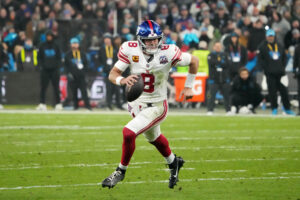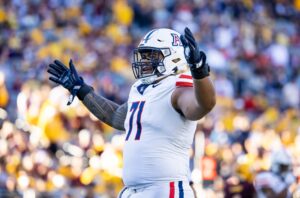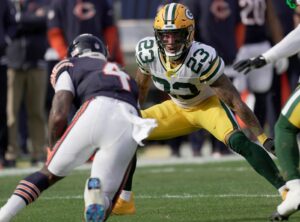If you were to ask football fans what they remember about Super Bowl XXXI, they’d probably say Brett Favre, something about the lineup, and “that really long pass to Antonio Freeman”. “That really long pass” was a Favre to Freeman 81 yard long bomb. The record setting touchdown pass became an instant classic, and Freeman finished the game with three receptions and 105 yards.
Antonio Freeman: Time to Celebrate
He did what?
Fast forward to November 6th, 2000, Green Bay in overtime against NFC North rivals Minnesota Vikings. Freeman catches an incomplete pass, laying on his back. At least that’s what it looked like, until Freeman suddenly jumped up and ran the ball for a game-winning touchdown. Turns out he knew what many spectators had missed. The ball had actually bounced from body part to body part – on him – without hitting the ground. The whistle never went, and so he was free to run the ball – and he did. Stunned by the unexpected turn of events, announcer Al Michaels exclaimed “He did what?!”
He did that, too!
Freeman, perhaps surprisingly, did not get much recruiting attention. He chose to attend Virginia Tech where he became a four-year letterman and played wide receiver from 1991 to 1994. At Virginia Tech, he set school records in receptions, receiving yardage, and touchdown catches. Arguably the best wide receiver in Virginia Tech history, Freeman was inducted to the Virginia Tech Sports Hall of Fame in 2006. While at Virginia Tech, Freeman didn’t “just” catch 93 passes for 1,534 yards, and scored 16 touchdowns over three seasons. He also returned 63 punts for 651 yards, and scored another touchdown. When Green Bay drafted him in the third round of the 1995 draft, the 90th pick overall, they used Freeman for punt- and kick returns. As a matter of fact, it was Freeman who, that year, became the first Packer to score on a punt return in the playoffs.
Antonio Freeman, 23-year-old Wunderkind
So, in that first season with the Packers, Freeman returned punts and kicks, and he played wide receiver. This must have felt overwhelming for a player who, at the time, was 23 years old. Not that he actually let any of that show on his face at that point. To fans, he looked fearless and athletic, even on days when he felt “used up.” He only made eight catches that season. Just a year later, Freeman emerged as the team’s number one wideout. He really started racking up great looking stats in the 1996 season. His best season was in 1998, when he led the NFL in receiving with 1,424 yards. That season also earned him a ticket to the Pro Bowl. Of course it helped, but honestly, that wasn’t just because he had Brett Favre throwing the ball at him, either.
A Downward Spiral
By the time we got to Super Bowl XXXI, Freeman had earned his Super Bowl ring fair and square. Eventually, though, came an off-season, right after a big signing bonus. Head coach Ray Rhodes was fired by then general manager Ray Wolf due to a lack of team discipline under Rhodes’ direction in 1999. At first, new coach Mike Sherman went easy on Freeman, who broke a string of rules early in the 2000 season. For example, when Freeman didn’t return on time after an October bye week, Sherman fined him. He could have suspended him, but he didn’t. Then there was a long string of other transgressions, missed practices and meetings.
The league fined Freeman $10,000 after he slapped the ball out of an official’s hand in a loss at Tampa. That unsportsmanlike conduct penalty cost the Packers 15 yards, pushing the team out of field-goal range. At the same time, Freeman seemed a mess off the field as well. There were fines, a probation, and community service meted out for obstructing police officers. Then came driver’s license suspensions and failing to show up for a court hearing, and multiple speeding tickets. In light of the Rhodes “lack of team discipline” firing, Sherman eventually had to do something. He suspended Freeman for the final game of the season after he missed yet another team meeting. By then, all the little missteps on and off the field had cost Freeman $50,000 in fines off the field and evolved into bigger issues on the field.
Freeman had become the “star with an attitude.” He returned to play for the Packers in 2001, but in 2002, Freeman went to play for the Philadelphia Eagles. A fresh start, perhaps, but the Packers missed him, and he seemed to echo that sentiment. In 2003, Sherman and Freeman had a sit-down to hash out their differences. Freeman came back to play for Green Bay, and played his final game with the team in January of 2004. He did suit up for the Miami Dolphins during training camp in 2004, but was only ever an offseason and practice squad member of the team. In the end, he signed with the Packers in 2007 to retire with the team.
Forgive, Forget and Celebrate
It is really unfortunate that this bad boy image has marred the memory of this otherwise illustrious career. As stated earlier, fans remember Freeman in Super Bowl XXXI. He made a dent in the stats, broke several records. In 2005 ESPN named the “He Did What” catch as the greatest play in the history of Monday Night Football. He won the 2006 Pop Warner Award for his work with youth. 2017 marks the third year that Freeman has participated in the annual Tellurian Celebrity Golf Tournament. The event is held in support of those recovering from drug addiction. Nobody is saying that he’s doing any of those things now to erase that bad image. On the other hand, maybe it’s time to forgive and forget? Or, maybe try to celebrate the good parts of this exceptional career more than previously.






